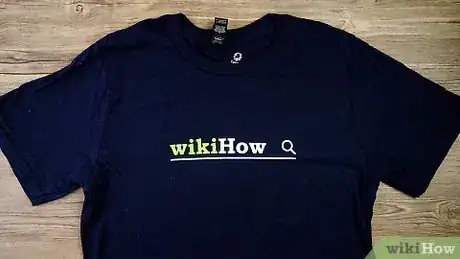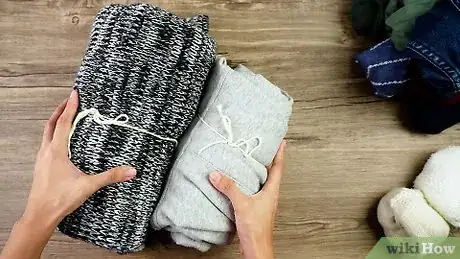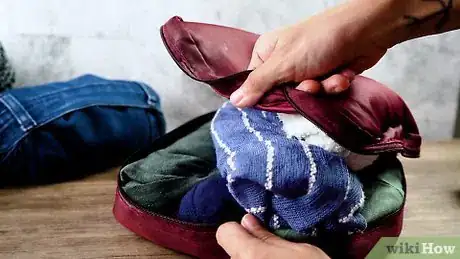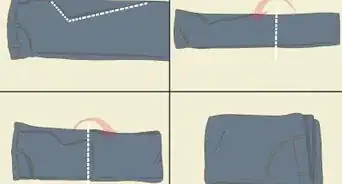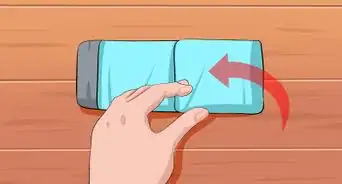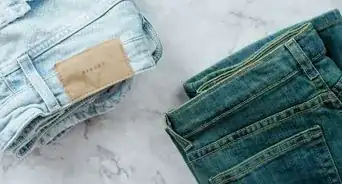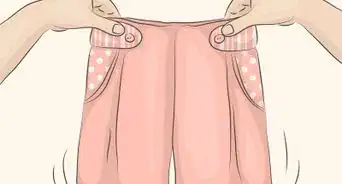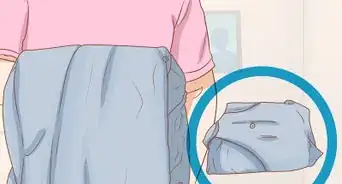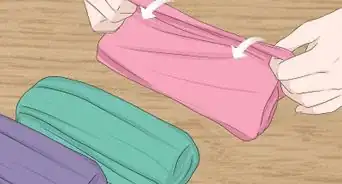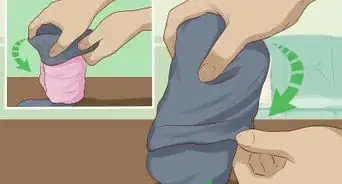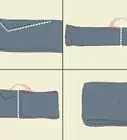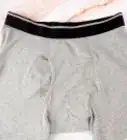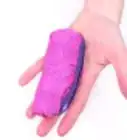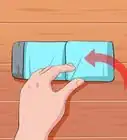This article was co-authored by Caitlin Jaymes. Caitlin Jaymes is a Closet Organizer and Fashion Stylist based in Los Angeles, California. With a background in Fashion PR and Fashion Design, she specializes in creating wardrobes for her clients with pieces they already own. She has experience working with celebrities, editorial shoots, and men and women of all ages. Caitlin uses fashion and organization to help instill and influence confidence, ambition, and stress-free lifestyles for all her clients. She runs her business by two guiding principles: “fashion has no rules, only guidance on how to look and feel your best” and “life has too many stressors, don’t let clutter be one of them.” Caitlin’s work has been featured on HGTV, The Rachael Ray Show, VoyageLA, Liverpool Los Angeles, and the Brother Snapchat Channel.
There are 22 references cited in this article, which can be found at the bottom of the page.
This article has been viewed 14,624 times.
Packing cubes can help you stay organized and use every inch of your luggage. Rolling shirts, pants, and smaller items like socks and underwear will save the most space. Rolling bulky jackets and winter coats isn't recommended because it may create excessive bulk, but it is possible if you’re packing a backpack or suitcase that allows for the extra volume. To utilize your packing cubes most efficiently, make sure to use the appropriate sizes so each one is full but not overstuffed. Organize the cubes by outfits, categories, or colors to help you find particular items once you’re at your destination.
Steps
Rolling Shirts
-
1Lay the t-shirt front-side up and flatten any wrinkles with your palms. Lay out the shirt in the way it's worn and use your palms to iron out any wrinkles. If it has sleeves, place those out to the sides as they naturally lie and smooth out any wrinkles.[1]
- To help you lay it out properly, grasp the shirt by the top of the shoulders and shake it a little before flopping it down onto a flat surface.
-
2Make a 3 in (7.6 cm) cuff at the bottom by folding it inside out. Grasp the base of the shirt with your thumbs under the top layer and your fingers on top. Then flip your wrists so your fingers scoop downward and then end pointing toward you to make the cuff. Repeat this process on the bottom layer of the shirt but flipping the fabric in the opposite direction so the cuff is uniform all the way around.[2]
- The seam at the base of the shirt should now be upside down on top of the front of the shirt (as if you’re turning the shirt inside out by a few inches).
- Note that this isn't recommended for dress shirts with stiff collars. You're better off folding those flat and placing them at the base of the packing cube.
Advertisement -
3Fold the right and left sides of the shirt into the center to make a rectangle. Just like you would fold a shirt into a square, fold in the right and left sides into the middle so they overlap by 4 inches (10 cm) to 6 inches (15 cm). The idea is to make the shirt as close to a rectangular shape as you can.[3]
- If the shirt has long sleeves, fold those into the center at a diagonal angle before folding in the entire sides.
- If the long-sleeved shirt has cuffs, fold them back upwards so the cuff is pressed against the bottom section of the sleeve.
-
4Roll the shirt from the neckline to the hem. Turn the shirt around so the neckline is closest to you and then start rolling it up like a burrito. Try to roll it as tightly as you can.[4]
- If any bulges start to stick out from the sides (distorting the rectangular shape) stop and fold that section inwards (to reinstate the rectangular shape) before rolling that section.
-
5Tuck the roll into the cuff at the base of the shirt. Once you've rolled the entire shirt, pick it up and stuff it into the cuff that you made at the beginning. This will keep the roll compact and intact.[5]
- If it's a tight fit, don't try to force it because you could stretch the fabric. Unroll it, make a bigger cuff, and try again.
Rolling Pants and Jeans
-
1Lay the pants face-up and flatten any creases with your palms. Place the pants on a flat surface and use your hands to iron out any creases or bumps. This will ensure that the pants can roll tightly with no air pockets or bunched fabric.[6]
- Lay the pants on a surface that allows you to access the jeans from both sides. The floor, a bed, or a large countertop will work.
-
2Grasp the waistline and turn it inside out to make a 4 in (10 cm) cuff. With the waistline closest to you, grip the top layer with your fingers on top and your thumb underneath. Flip your wrist so your fingers point down and then toward you to turn the waistline inside out. Do the reverse of this movement for the bottom layer (the back) of the jeans so the cuff is uniform around the entire waistline.[7]
- Note that the cuff-and-stuff technique will work for sweatpants, leggings, slacks, shorts, and jeans.
- If you're afraid of stretching out the waistline of your dress slacks, skip the cuff and secure the roll with a rubber band instead.
-
3Fold one leg over the other and flatten the fabric with your palms again. Lift one leg of the pants and fold it over so it's on top of the other leg. Then, use your hands to flatten the fabric again.[8]
- The idea is to get as much air and bunched material out of the pant legs as possible to ensure a tight roll.
-
4Roll the pants from the ankles to the waistline. Grasp the bottom of the legs with your thumbs under the material and your fingers on top. Then, roll it up like a burrito, squeezing it as tightly you can to ensure a compact roll.[9]
- If you’re rolling jeans, you may notice side bulges sticking out just above where you’re rolling the pant legs. Stop to tuck in any extra fabric and bulges so it’s easier to stuff the pants into the cuff.
-
5Pull the cuff around the rolled pants to secure the bundle. Stop rolling once you get to the base of the cuff and pull one lip of the cuff over the bundle on one side. Pull the cuff over the other side to secure it and then tuck any extra fabric in the center of the bundle into the middle of the cuff.[10]
- Stuffing bulky pants and jeans into the cuff can be tricky, so it's okay if you can only get the sides in. As long as stays rolled up, you’re good to go!
- If you can't fully tuck the pants or jeans into the cuff, secure the bundle with a rubber band.[11]
Rolling Socks, Underwear, and Accessories
-
1Stack 2 socks, roll from the toes to the cuffs and fold the cuffs over the roll. Lay 1 sock on top of the other with the toes and heels together. Tightly roll the socks into a burrito shape from the toes up to the cuff. Then pull one side of one cuff around the bundle to secure it.[12]
- As you're rolling the heel area, it may help to slightly fold the heels in to avoid them bulging out of the side of the roll.
-
2Make a cuff at the waistline of the underwear, fold each side in, then roll and tuck. Lay the underwear flat (front-side up) and fold a 2 inches (5.1 cm) cuff at the waistline. Fold the right and left sides inward to create a rectangle and then start rolling from the crotch of the underwear. Tuck the roll into the cuff once you reach the top.[13]
- This cuff-roll-and-tuck technique will work for briefs, boxers, bikini-style panties, and boyshorts.
- If you're rolling underwear made of thin material (like lace, rayon, or spandex, feel free to roll 2 to 4 pairs into a single bundle by making a giant cuff with the waistline of the underwear at the base of the pile.
-
3Fold ties and scarves in half and roll them up into small burrito shapes. Drape the middle of the tie or scarf over your hand to fold it in half. Roll the tie or scarf from the folded side (not the side with the loose ends). Secure the burrito with a rubber band or pack the roll immediately to hold it together.[14]
- Rolling your ties can prevent wrinkles and creases.
- Depending on the width of the scarf, you may want to fold it in half lengthwise before folding it widthwise.
- If your scarf has tassels on each end, fold in the tassels before you do anything else.
-
4Lay both gloves together and make a fold with the cuffs, then roll and tuck. Start with both gloves on top of each other, lining up the palms and fingers. Then fold the base of the gloves up 1.5 inches (3.8 cm) to form a cuff. Fold each side of the gloves into the center to make something similar to a rectangle. Then roll it up from the fingers and tuck the roll into the cuff you made at the beginning.[15]
- Depending on the shape of the gloves, you may need to fold the thumbs in before you fold each side of the gloves in towards the center.
Rolling Bulky Sweaters and Jackets
-
1Zip or button the garment and fold the sleeves into the center. Buttoning or zipping the sweater or jacket all the way up will help the item be as compact as possible and retain its shape when you roll it. Fold each sleeve into the center so they're forming an "X".[16]
- For puffy parkas, avoid making an "X" because it might add extra bulk—fold the sleeves in so the base of the sleeves are almost touching at the bottom of the jacket.
- If the sleeves hang down below the base of the item, fold the base of the sleeves back up so they won't hang out of the bundle.
-
2Fold each side of the garment into the center to form a rectangle. Lift each side of the sweater or jacket and fold it into the center. Depending on how large and puffy the garment is, two sides will overlap by 3 inches (7.6 cm) to 7 inches (18 cm).[17]
- Note that the more the folds overlap, the bulkier the rolled bundle will be, so if you'd rather have a long, less bulky roll, fold in each side so they're just touching in the center.
- If you're working with a puffer jacket or bulky parka, you may need to roll the sides inward and have a helper hold them in place while you roll it up.
-
3Push air out of the garment and roll it up from the bottom. Use your hands to press out as much air from the garment as you can. Then, start rolling the garment from the bottom.[18]
- You may need to press air out of the garment multiple times as you roll it up.
-
4Secure the roll with 1 or 2 heavy-duty strings depending on the size. Once you've rolled it to the neckline, slide a long piece of thick string under the burrito-shaped bundle and tie it closed at the center. Depending on the width of the bundle, you may need to do this on each side.[19]
- If you're working with a camping parka that came with a packing strap, use that to keep the bundle together.
- If the sweater or jacket has a large hood, tuck the roll into the hood if you can. Or, wrap the hood around the bundle and secure it with heavy-duty string or a strap.
Packing and Organizing the Cubes
-
1Pack bulky items into larger cubes first, if applicable. If you're packing bulky sweaters, jackets, and pants that are either rolled or folded flat, pack those into a larger packing cube first (if you have one). If you don’t have a large packing cube, feel free to set them on the bottom of your suitcase so you can put the smaller cubes on top.[20]
- You’ll have more usable space in a large packing cube if you save room for rolled items on top of any flat-folded items.
-
2Use small cubes for small items and medium or larger ones for bigger items.[21] Using an appropriately-sized packing cube will ensure your items don’t move around inside the cube. Use small or extra-small cubes for things like underwear, socks, gloves, and ties. Shirts and pants can go into medium-sized cubes and larger items are best packed in large cubes.[22]
- If you have a few extra-bulky items like parka jackets, try rolling and putting them in large cubes or folding them flat and laying them at the bottom of your suitcase. You may need to experiment to see which method takes up less space.
- Small and medium cubes are more versatile than larger ones because they can fit into a variety of bags (from backpacks and duffle bags to massive suitcases).
-
3Pack according to outfits, categories, or colors to stay organized.[23] If you want to be able to easily locate items without having to unpack each cube, organize your garments by outfit (e.g., Monday's work attire, Tuesday's dinner outing), category (e.g., pants with pants, tops with tops), or color (e.g. blue shirts, black shirts).[24]
- If you're traveling with children, organizing the cubes by outfits can make getting them dressed easier and faster.
- Organizing by color is helpful if you build outfits according to color schemes.
-
4Avoid under or over-filling the packing cubes. Pack enough clothes in the packing cubes to prevent them from unrolling and moving around inside the cube (which could cause lots of wrinkles). Similarly, don’t stuff the cubes because that will put stress on the zippers and may cause trouble when it’s time to zip up your outer luggage.[25]
- Some cubes have extra compression zippers that allow the cube to be overstuffed then zipped again to decrease the size of the overall cube.
- If you’ve packed a large or medium packing cube and there’s room for the clothes to move around or unroll, transfer the items into 2 or 3 small packing cubes so they stay put.
Warnings
- The more compressed your clothing is in the cube, the more likely it is that you’ll have wrinkles and creases.⧼thumbs_response⧽
References
- ↑ https://youtu.be/6thfS0u2fpk?t=3
- ↑ https://youtu.be/6thfS0u2fpk?t=3
- ↑ https://youtu.be/6thfS0u2fpk?t=7
- ↑ https://youtu.be/6thfS0u2fpk?t=12
- ↑ https://youtu.be/6thfS0u2fpk?t=19
- ↑ https://youtu.be/6thfS0u2fpk?t=117
- ↑ https://youtu.be/6thfS0u2fpk?t=117
- ↑ https://youtu.be/6thfS0u2fpk?t=126
- ↑ https://youtu.be/6thfS0u2fpk?t=126
- ↑ https://youtu.be/6thfS0u2fpk?t=138
- ↑ https://youtu.be/6thfS0u2fpk?t=202
- ↑ https://youtu.be/griS9wKF8aA?t=10
- ↑ https://youtu.be/V9lj_g779Io?t=14
- ↑ https://youtu.be/yIbPEETINkU?t=67
- ↑ https://youtu.be/Q4T6qWZ66Ns?t=167
- ↑ https://youtu.be/pZL5TNcRiKo?t=32
- ↑ https://youtu.be/oXR20VGH2pw?t=57
- ↑ https://youtu.be/oXR20VGH2pw?t=65
- ↑ https://youtu.be/oXR20VGH2pw?t=97
- ↑ https://practicaltravelgear.com/guides/the-pros-and-cons-of-packing-cubes/
- ↑ Caitlin Jaymes. Closet Organizer & Fashion Stylist. Expert Interview. 16 December 2019.
- ↑ https://youtu.be/4fJp1naw7lc?t=153
- ↑ Caitlin Jaymes. Closet Organizer & Fashion Stylist. Expert Interview. 16 December 2019.
- ↑ https://www.cntraveler.com/story/how-to-pack-a-suitcase-according-to-a-luggage-designer
- ↑ https://youtu.be/4fJp1naw7lc?t=112
- ↑ https://www.youtube.com/watch?v=4fJp1naw7lc
About This Article
Packing cubes are a great way to maximize space in your luggage and keep your clothes organized. To roll a tee-shirt for a packing cube, lay the shirt front-side up and smooth it out with your hands. Roll up the bottom part of the shirt about 3 inches to create a cuff, then fold in the left and right sides of the shirt to make it into a rectangle. Roll the shirt up neatly from the neck to the hemline, then tuck the rolled up shirt into the cuff you made at the bottom. Scroll down for tips on how to roll other items, like pants and socks!
